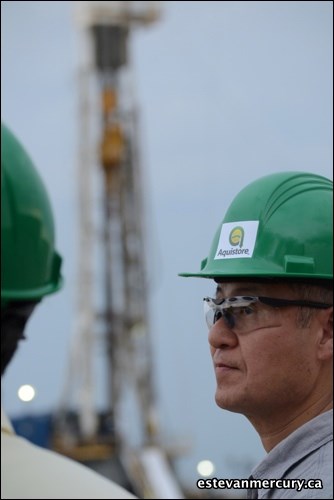They've drilled the deepest hole that's ever been dug in Saskatchewan. At a total depth of 3,396 metres or about 3.3 kilometres down, the Petroleum Technology Research Centre's (PTRC) Aquistore primary well in southeast Saskatchewan is officially the deepest hole ever drilled in this province.
"This project is already the first of its kind in the world, so to find that we drilled the deepest well is a nice surprise," said Malcolm Wilson, PTRC's CEO.
Prior to this, the deepest hole was also drilled in the southeast, an oil-bearing hole in the Torquay-Outram area.
It was confirmed Aug. 31 by the Saskatchewan Ministry of the Economy that at 3,396 metres total vertical depth, the Aquistore well is the deepest well drilled to date in the province.
The well, located near Estevan, will be used as a deep saline carbon dioxide storage site for the SaskPower Boundary Dam carbon capture project. Together the two will meet the emission reduction targets by taking captured CO2 gases from the emissions coming from the newly refurbished Boundary Dam Unit No. 3 (BD3) and sequester them deep underground.
The $1.23 billion BD3 clean coal venture is being observed by many global power suppliers since it will be the first commercial-sized exhibit of carbon dioxide capture and storage techniques once it is completed in 2013.
PTRC is attempting to demonstrate that deep geological storage of industrial CO2 is safe and economically and environmentally feasible since it is geared to reduce greenhouse gases to meet Canada's climate change goals.
"The Aquistore project is an important one as it puts Estevan and Saskatchewan on the world stage," said Wilson.
The BD3 unit will be pumping out approximately 110 megawatts of electrical power into the Saskatchewan grid while capturing most of the carbon dioxide and other noxious and useful gases. CO2 can be used as an agent to enhance oil recovery practices in the southeast Saskatchewan oil patch.
The long-range plan will be to have some, or all, of the carbon dioxide that is captured used to recover oil by piping it into nearby concentrated oil bearing sites which will extend their production lives.
The drilling to the deepest point ever took 58 days, said Kevin Brydges, drilling supervisor for Aquistore.
"Once operational it will be the first of its kind, and being the deepest brings it additional recognition." he said.
Aquistore will become a primary data point for the deeper Deadwood geological formation, the deepest sedimentary unit in the Williston Basin. Research is the essential component of the entire project, so the Aquistore well will be used for evaluation since it is heavily instrumented with monitoring equipment.
"The comprehensive suite of well logs and core samples is creating a buzz within the industry," said Kyle Worth, Aquistore's project manager. "To have quality cores from such a depth is a rarity and our science and engineering research committee is eager to analyze the samples."
The complete set of logs and other data that accompany the well will be useful not only for CO2 storage, but also for oil companies in the area who have interests in hydrocarbon bearing formations.
A second observation well will be drilled after the primary one is completed. That process will begin, probably in October. The observation well could reach a comparable depth. Wilson said the second well will contribute significantly to the data already being collected and might even beat PTRC's just-established record.
Background:
Aquistore is an independent research and monitoring project which intends to demonstrate that storing liquid carbon dioxide deep underground in a brine and sandstone water formation is a safe, workable solution to reduce greenhouse gases. Deep saline aquifers have the potential to store centuries' worth of CO2 emissions.
Aquistore, a $26.5 million research project, is the first commercial scale deep saline injection project in the world, even though injecting CO2 into geological formations is not new, the North American oil industries have the most extensive experience with the process, using it for enhanced oil recovery.
PTRC is a not-for-profit corporation whose primary focus is on research of sustainable development technologies for the petroleum industry.



